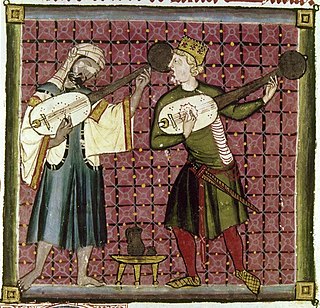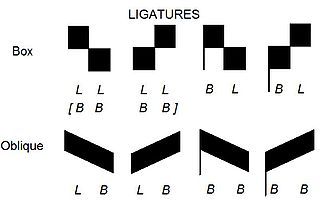In the theory of Western music, a mode is a type of musical scale coupled with a set of characteristic melodic behaviors. Musical modes have been a part of western musical thought since the Middle Ages, and were inspired by the theory of ancient Greek music. The name mode derives from the Latin word modus, "measure, standard, manner, way, size, limit of quantity, method".

Medieval music consists of songs, instrumental pieces, and liturgical music from about 500 A.D. to 1400. Medieval music was an era of Western music, including liturgical music used for the church, and secular music, non-religious music. Medieval music includes solely vocal music, such as Gregorian chant and choral music, solely instrumental music, and music that uses both voices and instruments. Gregorian chant was sung by monks during Catholic Mass. The Mass is a reenactment of Christ's Last Supper, intended to provide a spiritual connection between man and God. Part of this connection was established through music. This era begins with the fall of the Western Roman Empire in the fifth century and ends sometime in the early fifteenth century. Establishing the end of the medieval era and the beginning of the Renaissance music era is difficult, since the trends started at different times in different regions. The date range in this article is the one usually adopted by musicologists.

Music notation or musical notation is any system used to visually represent aurally perceived music played with instruments or sung by the human voice through the use of written, printed, or otherwise-produced symbols, including notation for durations of absence of sound such as rests.
In Western musical notation, the staff (US) or stave (UK) is a set of five horizontal lines and four spaces that each represent a different musical pitch or in the case of a percussion staff, different percussion instruments. Appropriate music symbols, depending on the intended effect, are placed on the staff according to their corresponding pitch or function. Musical notes are placed by pitch, percussion notes are placed by instrument, and rests and other symbols are placed by convention.
Semiology is a branch of Gregorian Chant research. Semiology refers specifically to the study of the neumes as found in the earliest fully notated manuscripts of Gregorian Chant, the oldest of which have been dated to the 9th century. The first application of the term 'semiology' for the study of Latin chant was made by Dom Eugène Cardine (1905–1988), a monk of the Abbey of Solesmes. In this context, 'semiology' is understood as 'the study of musical signs'. Text and neumatic notation, together with significative letters adjoined to the neumes, presents an effective and integrated mnemonic for the rhythmical interpretation and the melody. While Gregorian palaeography offers a description of the various neumes and their rhythmical and melodic values, Gregorian semiology explains their meaning for practical interpretation.
Plainsong is a body of chants used in the liturgies of the Western Church. Though the Catholic Church and the Eastern Orthodox churches did not split until long after the origin of plainsong, Byzantine chants are generally not classified as plainsong.

The uilleann pipes are the characteristic national bagpipe of Ireland. Earlier known in English as "union pipes", their current name is a partial translation of the Irish-language term píobaí uilleann, from their method of inflation. There is no historical record of the name or use of the term uilleann pipes before the twentieth century. It was an invention of Grattan Flood and the name stuck. People mistook the term 'union' to refer to the 1800 Act of Union; this is incorrect as Breandán Breathnach points out that a poem published in 1796 uses the term 'union'.

Gregorian chant is the central tradition of Western plainchant, a form of monophonic, unaccompanied sacred song in Latin of the Roman Catholic Church. Gregorian chant developed mainly in western and central Europe during the 9th and 10th centuries, with later additions and redactions. Although popular legend credits Pope Gregory I with inventing Gregorian chant, scholars believe that it arose from a later Carolingian synthesis of Roman chant and Gallican chant.

In music notation, a ligature is a graphic symbol that tells a musician to perform two or more notes in a single gesture, and on a single syllable. It was primarily used from around 800 to 1650 AD. Ligatures are characteristic of neumatic (chant) and mensural notation. The notation and meaning of ligatures has changed significantly throughout Western music history, and their precise interpretation is a continuing subject of debate among musicologists.
The Antiphonary tonary missal of St. Benigne was supposed to be written in the last years of the 10th century, when the Abbot William of Volpiano at St. Benignus of Dijon reformed the liturgy of several monasteries in Burgundy. The chant manuscript records mainly Western plainchant of the Roman-Frankish proper mass and part of the chant sung during the matins, but unlike the common form of the Gradual and of the Antiphonary, William organized his manuscript according to the chant genre, and these sections were subdivided into eight parts according to the octoechos. This disposition followed the order of a tonary, but William of Volpiano wrote not only the incipits of the classified chant, he wrote the complete chant text with the music in central French neumes which were still written in campo aperto, and added a second alphabetic notation of his own invention for the melodic structure of the codified chant.

A neume is the basic element of Western and Eastern systems of musical notation prior to the invention of five-line staff notation.

The Gradual is a chant or hymn in the liturgical celebration of the Eucharist in the Catholic Church, and among some other Christians. It gets its name from the Latin gradus because it was once chanted on the step of the ambo or altar. In the Tridentine Mass it is sung after the reading or chanting of the Epistle and before the Alleluia, or, during penitential seasons, before the Tract. In the Mass of Paul VI, the Gradual is usually replaced with the responsorial psalm. Although the Gradual remains an option in the Mass of Paul VI, its use is extremely rare outside monasteries. The Gradual is part of the Proper of the Mass.

In medieval music, the rhythmic modes were set patterns of long and short durations. The value of each note is not determined by the form of the written note, but rather by its position within a group of notes written as a single figure called a "ligature", and by the position of the ligature relative to other ligatures. Modal notation was developed by the composers of the Notre Dame school from 1170 to 1250, replacing the even and unmeasured rhythm of early polyphony and plainchant with patterns based on the metric feet of classical poetry, and was the first step towards the development of modern mensural notation. The rhythmic modes of Notre Dame Polyphony were the first coherent system of rhythmic notation developed in Western music since antiquity.
Svara or swara is a Sanskrit word that connotes a note in the successive steps of the octave. More comprehensively, it is the ancient Indian concept about the complete dimension of musical pitch.

In music, a notehead is the part of a note, usually elliptical in shape, whose placement on the staff indicates the pitch, to which modifications are made that indicate duration. Noteheads may be the same shape but colored completely black or white, indicating the note value. In a whole note, the notehead, shaped differently than shorter notes, is the only component of the note. Shorter note values attach a stem to the notehead, and possibly beams or flags. The longer double whole note can be written with vertical lines surrounding it, two attached noteheads, or a rectangular notehead. An "x" shaped notehead may be used to indicate percussion, percussive effects, or speaking. A square, diamond, or box shaped notehead may be used to indicate a natural or artificial harmonic.
A tonary is a liturgical book in the Western Christian Church which lists by incipit various items of Gregorian chant according to the Gregorian mode (tonus) of their melodies within the eight-mode system. Tonaries often include Office antiphons, the mode of which determines the recitation formula for the accompanying text, but a tonary may also or instead list responsories or Mass chants not associated with formulaic recitation. Although some tonaries are stand-alone works, they were frequently used as an appendix to other liturgical books such as antiphonaries, graduals, tropers, and prosers, and are often included in collections of musical treatises.
Petasti is a neume of Byzantine chant notation, which is usually called a flutter in English. In the most general form it means "Go one note up, and stress this note", where the "stress" is usually interpreted either as a mordent of Western music, as a triplet, or as a sequence of two eighth notes and a quarter note.

Mechanical music technology is the use of any device, mechanism, machine or tool by a musician or composer to make or perform music; to compose, notate, play back or record songs or pieces; or to analyze or edit music. The earliest known applications of technology to music was prehistoric peoples' use of a tool to hand-drill holes in bones to make simple flutes. Ancient Egyptians developed stringed instruments, such as harps, lyres and lutes, which required making thin strings and some type of peg system for adjusting the pitch of the strings. Ancient Egyptians also used wind instruments such as double clarinets and percussion instruments such as cymbals. In Ancient Greece, instruments included the double-reed aulos and the lyre. Numerous instruments are referred to in the Bible, including the horn, pipe, lyre, harp, and bagpipe. During Biblical times, the cornet, flute, horn, organ, pipe, and trumpet were also used. During the Middle Ages, hand-written music notation was developed to write down the notes of religious Plainchant melodies; this notation enabled the Catholic church to disseminate the same chant melodies across its entire empire.

Jacques Viret is a contemporary French musicologist of Swiss origin.
Repercussion is a special vocal singing technique consisting on singing a tone with a constant pitch.











